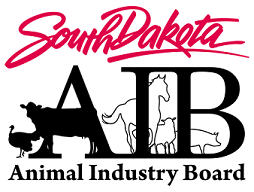South Dakota Bovine Tuberculosis Update January 2019
Since February, 2017, Bovine Tuberculosis (TB) has been confirmed in four SD beef herds, and was also traced to two SD feedlots.
Harding County February 2017
TB was identified in three beef cows during routine slaughter inspection by USDA Food Safety Inspection Service inspectors at two Nebraska slaughter plants in February, 2017. The cows had been in feedlots in Nebraska and South Dakota since November, 2016. Official identification and market records were used to identify the herd of origin in Harding County (northwestern South Dakota), which was tested by state and federal animal health officials, revealing 38 additional infected animals.
The index ranch in Harding County (approximately 650 hd.) was depopulated. Test negative animals were sent to inspected slaughter, revealing three additional infected cows. Cleaning and disinfection of conveyances, water tanks, and other potential sources of contamination was completed. This herd has begun to restock.
State and federal animal health officials used sales records, official animal identification records, and certificates of veterinary inspection to identify animals that may have originated in the index herd and moved to other herds. Two other herds, one in Harding County and one in Butte County, were each found to have an infected animal from the index herd. Each herd completed three negative herd tests and was released from quarantine in Fall of 2017.
Nearly 12,000 head of cattle in adjacent and exposed herds were tested during this response. No other TB infected animals were found.
In Fall of 2018, SDAIB conducted TB herd tests on the restocked cattle in the index herd and on adult cattle in the other affected herd in Harding County. All cattle were TB negative. The Butte County herd had dispersed.
Molecular characterization of Mycobacterium bovis, the causative agent of bovine tuberculosis, from the infected animals has identified this strain as being very similar to a strain identified in Queretaro, Mexico in 1997. This strain is new to the U.S., and it's pathway of introduction into the Harding County herd remains unknown.
Tripp County October 2017
A four-year-old cow culled from a Tripp County beef herd was identified in October 2017 by federal meat inspectors during routine inspection at a Texas slaughterhouse and found to be TB positive. Official animal identification records linked the cow to the index herd in Tripp County. Herd testing and laboratory confirmation revealed 39 additional infected animals in the herd.
The Tripp County index herd (approximately 340 hd.) was depopulated. Feeder calves on the premises were fed until finished and then sent to slaughter. Cleaning and disinfection of conveyances, water tanks, and other potential sources of contamination was completed. A herd test is planned for spring 2019 on restocked cattle on the premises.
Over 4,000 head in 10 adjacent herds were TB tested and none were found to be infected. Records of sales out of the herd were traced, most of which were feeder cattle. Additional TB positive animals were found: one adult cow in a SD feedlot, one heifer in a central NE herd, and one adult cow in an IA feedlot.
The genetic analysis of the M. bovis bacteria recovered from the index cow indicates that it is a novel strain that has not previously been identified in the U.S. It is a different strain than that which was identified in Harding Co. earlier in 2017. The source of TB has not been identified in this case.
SD Feedlot June 2018
Bovine tuberculosis (TB) was identified in a beef steer during routine slaughter inspection by USDA inspectors at a South Dakota slaughter establishment in June, 2018. The steer was shipped from a finishing feedlot in Potter County, SD. Beef steers are not required to have official identification, so no official ID was collected at slaughter. Feedlot records indicate that the lot of steers containing the TB infected steer had been purchased at a South Dakota auction market in October 2017. Subsequent examination of market records indicated that the steers in that group were consigned by a backgrounder who originally purchased the calves at auction markets in late winter/early spring of 2017. Auction market records showed that cattle were sourced from 99 different premises in five states (SD, ND, MT, WY, and MN).
The genetic analysis of the M. bovis bacteria recovered from the steer indicates that it is a novel strain that has not previously been identified in the US and does not match either of the two strains isolated from the beef herds in 2017.
In an attempt to find the source of the TB infection, State animal health officials in the five states with possible source herds have contacted the 99 producers and have begun conducting TB herd tests where appropriate. Testing began in Fall 2018 and will continue into Spring 2019.
SD Feedlot December 2018
Bovine tuberculosis (TB) was identified in a beef steer during routine slaughter inspection by USDA inspectors at a South Dakota slaughter establishment in December 2018. Once again, since beef steers are not required to have official identification, no official ID was collected at slaughter. The steer was shipped from a finishing feedlot in Kingsbury County, SD. Feedlot records indicate that the lot of steers containing the TB infected steer was made up of purchased steers and steers raised on the premises. The investigation is on-going.
Additional Links:
April 6, 2018 Bovine Tuberculosis Found in Tripp County

For Additional Information
Please Call 605.773.3321